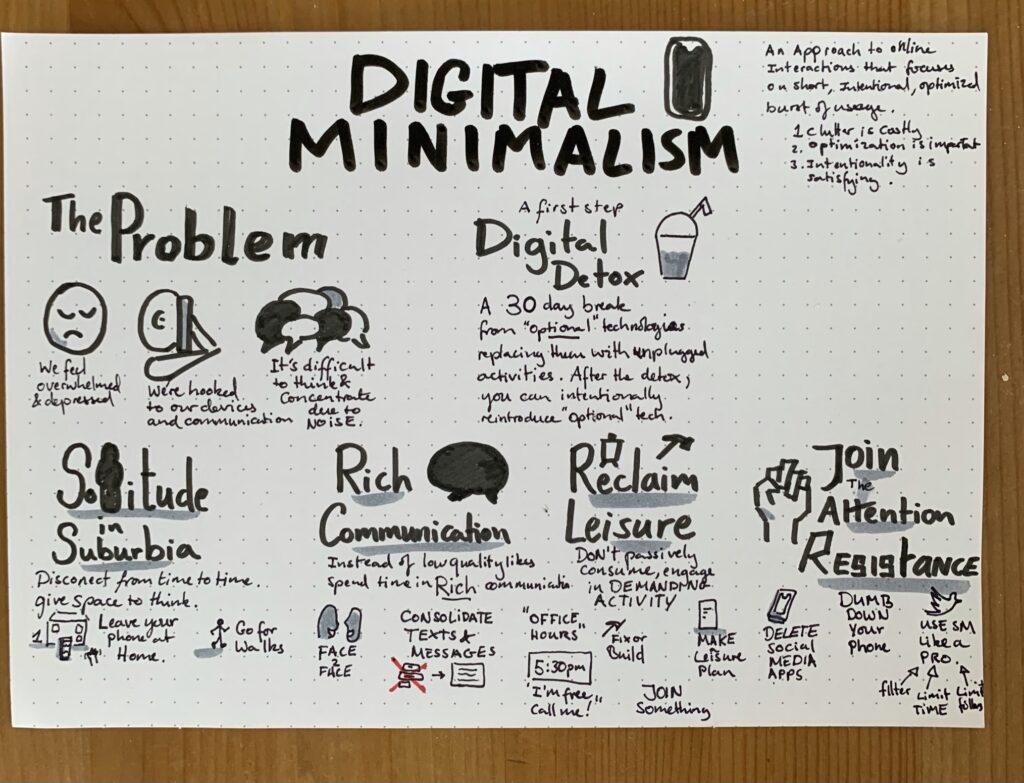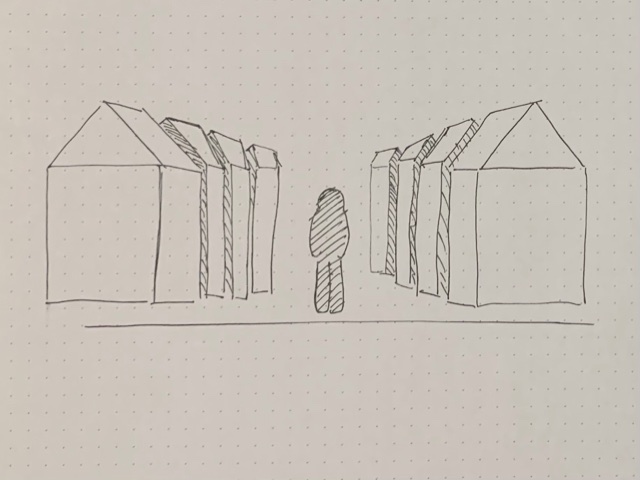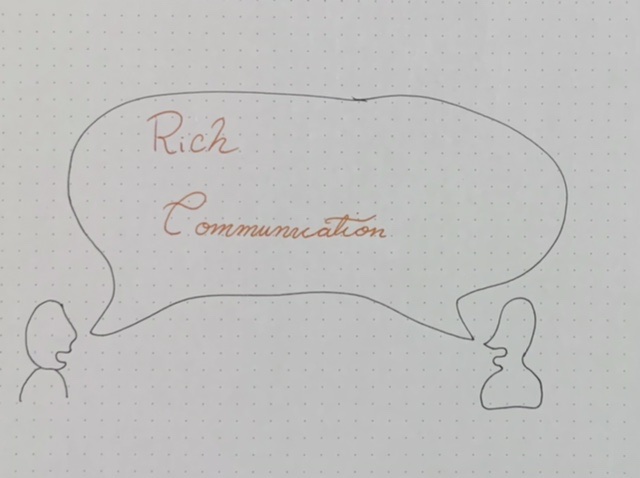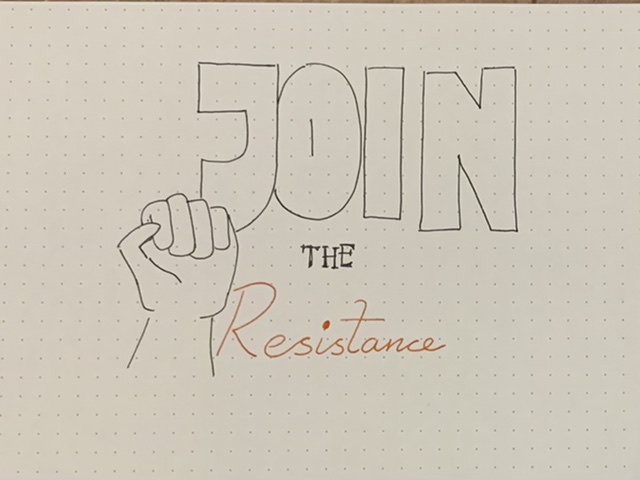I grabbed a copy of digital minimalism as soon as it came out. After reading Cal Newport’s previous book, Deep Work, I knew it would be good. But there was another reason driving my reading that you may well be able to relate to.
I felt like the constant noise of the online world was just a bit too much. I loved the benefits of online tools, websites and communication, but it felt like a bike going down a steep hill that had changed from fun to unable to stop.
A few weeks back, I felt that same feeling again and as I woke up and found myself with my phone in my hand before a cup of coffee was there, I knew I needed to reread and reapply the lessons of the book.
So here is my book summary.
Digital Minimalims Sketchnote summary

Yes, for the sketchnote summary of digital minimalism I went back to analog sketchnoting using my Neuland markers.
The most common approach to technology
Cal calls this approach “digital maximialism”: freely adopting any new technology that seems to offer some benefit to us.
This can seem a natural idea and positive as we gain the real benefits that these new tools offer us. A small example is that I can be connected with my family who live in a different country and my daughter has grown up speaking with her grandparents even though she hasn’t been able to see them in over a year due to the covid restrictions.
The problem of digital maximialism
There are there consequences that come out from our wild use of social media and related technology. These include
- increased dissatisfaction and depression.
- We’re hooked on the short term rewards from using our devices. This reduces our capacity to focus for a long period of time.
- It becomes difficult to concentrate due to the noise and anxiety we feel
The net effect is we are less happy and less able to do the activities which are deeply satisfying.
What is digital minimalism
The alternative to this technological maximialist approach is Digital minimalism.
Digital minimialsm is an approach to using technology that focuses on getting the most of the benefits we wants from technology, in the least time via intentional and focused use.
Cal focuses on short bursts of time, but with high intentionality and optimized practices. A practical example is we don’t log on to social media whenever we want to mindlessly scroll, instead we schedule when we will log on for a time limited period and with clear goals before we do so.
A Digital Detox to readjust
The practices at the heart of digital minimalism.
A key part of digital minimalism is the practices that can help you apply these ideas in your life. One of the aspects I really appreciated is the positive actions not just negative avoidance. These are split into four sections.
1. Solitude in Suburbia

One of the key steps is to disconnect from all the noise around us and create our own “waldens” like Thoreau. Cal notes that during Thoreau’s stay at Walden pond, he was still connected to society and could still receive visitors or take the 30 min trip to the centre of town, at the same time, it was an intentional disconnecting.
Some practical ideas includes.
- Leave your phone at home – go for walks without it. Enjoy the silence.
- Go for walks
2. Engage in Rich Communications

Not all communication is equal. Some is richer than others. A quick “like” on social media isn’t as rich as a sit down conversation due to the deeper engagement of your senses.
However, these low quality communications feel satisfying as we get a hit of dopamine. These hits encourage us to stick to these lower quality communications.
Here are some practices
- Avoiding hitting like
- Find face 2 face communication opportunities (in person is best, video next.)
- Instead of sending text messages throughout the day, set certain times to work through text messages (applies to email et al)
- Set communication “Office hours” regular times when you can be contacted.
- You could be in a physical place too.
3. Reclaim Leisure
Most of us spend our free time passively consuming netflix or social media. While neither activity is wrong, the issue is unintentionality. It is better to have a plan for leisure that involves demanding activities. Here are some ideas.
- Fix or build something each week (even if you aren’t naturally skilled. Developing and growing is rewarding).
- Make a leisure plan (Decide what goals you will work towards in your free time)
- Join something (groups and communities provide richer experiences )
4. Join the attention resistance.

The final practice involves activities that push back on attention stealing services and devices. While many people will accept the earlier practices, the following are the most likely to result in a “but you’ll miss out” reaction. At the same time, they are key to a full picture of digital minimalism.
- delete social media apps
- dumb down your phone
Use social media like a pro
Those who use social media for their profession often employee very different tactics to the average consumer. This is due to their focused goals and need to get the maximum value in the shortest time. These professional social media users can help provide a model for us regular users to more effectively engage with social media.
- Limit your time on social media – set deliberate times, don’t constantly use.
- Use filtered lists and searches to find really valuable content (The twitter advanced search can let you find the most engaged tweets on a certain topic which are more likely to be high value.)
- Limit the number of people you follow. (You might want to consider Dunbar’s number as your guide. )
How I’m applying Digital minimalism.
As I said at the start, this is my second time working through digital minimalism. Although I introduced many of the old measures and intended to introduce others, overtime I stopped being as intentional.
In my first pass, I
- deleted my social media apps and set up limits using Apple’s limit features
- reduced the number of people I followed on Social media
- tried leaving my phone at home
- set two quarter’s of leisure goals.
- Took more walks
- avoided hitting like
The practices I stuck to the best were walking more and reducing the number of people I follow. These are activities that have stuck around and the second was one I can occasionally do but regularly benefit from. The most difficult to implement have been those that require multiple other people such as joining a club and office hours.
I am only a couple of weeks into my return to digital minimalism so it’s difficult to say how well these practices will actually turn out but I want to share my ideas anyway.
I’ve set Saturday as a digital downtime day. This is my day to leave the phone at home and do something physical as well as spend time with people. That’s been the big difference so far, I have both the negative idea (get away from the phone/screens) with a positive (spend quality time with people).
Building and fixing is the practice I most neglected last time and yet is the one that appeals deeply to me this time. The closest practice I could point to that I previously took up was calligraphy but that slowly drifted to being mostly digital on an iPad.
This time I am interested in doing more DIY projects as well as investigating some wood craft to learn to make a ukulele.
Our recent DIY projects have set a great start and I intend to continue, but intentions are a dime a dozen so we’ll have to watch how this turns out.
Get your copy of Cal’s book
if this has whet your appetite for Cal’s book and you want to know some more details of the problems with Social media, why the practices are beneficial and how you can apply them, use the link below.

Leave a Reply